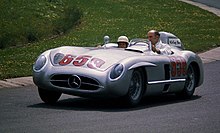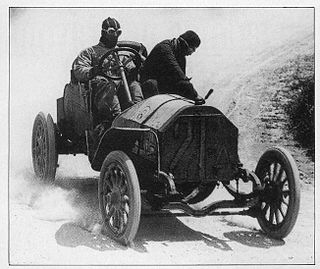
The Targa Florio was a public road endurance automobile race held in the mountains of Sicily near the island's capital of Palermo. Founded in 1906, it was the oldest sports car racing event, part of the World Sportscar Championship between 1955 and 1973. While the first races consisted of a whole tour of the island, the track length in the race's last decades was limited to the 72 km (45 mi) of the Circuito Piccolo delle Madonie, which was lapped 11 times.

The 1955 Monaco Grand Prix was a Formula One motor race held at Monaco on 22 May 1955. It was race 2 of 7 in the 1955 World Championship of Drivers and was given an honorary name, Grand Prix d'Europe. The 100-lap race was won by Ferrari driver Maurice Trintignant after he started from ninth position. Eugenio Castellotti finished second for the Lancia team and Maserati drivers Jean Behra and Cesare Perdisa came in third.

The 1957 Formula One season was the 11th season of FIA Formula One motor racing. It featured the 8th World Championship of Drivers which was contested over eight races between 13 January and 8 September 1957. The season also included nine non-championship races for Formula One cars.

The 1956 Formula One season was the tenth season of FIA Formula One motor racing. It featured the seventh World Championship of Drivers, which was contested over eight races between 22 January and 2 September 1956. The season also included nine non-championship races for Formula One cars.

The 1955 Formula One season was the ninth season of FIA Formula One motor racing. It featured the sixth World Championship of Drivers, which was contested over seven races between 16 January and 11 September 1955. The season also included several non-championship races for Formula One cars.

The 1954 Formula One season was the eighth season of FIA Formula One motor racing. It featured the fifth World Championship of Drivers, which was contested over nine races between 17 January and 24 October 1954. The season also included several non-championship races for Formula One cars.

Luigi Musso was an Italian racing driver, who competed in Formula One from 1953 to 1958. Musso won the 1956 Argentine Grand Prix with Ferrari.
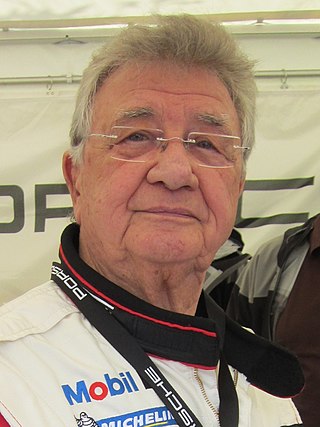
Hans Herrmann is a retired Formula One and sports car racing driver from Stuttgart, Germany.
The 1955 Le Mans disaster was a major crash that occurred on 11 June 1955 during the 24 Hours of Le Mans motor race at Circuit de la Sarthe in Le Mans, Sarthe, France. Large pieces of debris flew into the crowd, killing 83 spectators and French driver Pierre Levegh, and injuring around 120 more. It was the most catastrophic crash in motorsport history, prompting multiple countries in Europe to ban motorsports nationwide; Switzerland only lifted its ban in 2022.

The Mercedes-Benz W196 was a Formula One racing car produced by Mercedes-Benz for the 1954 and 1955 F1 seasons. Successor to the W194, in the hands of Juan Manuel Fangio and Stirling Moss it won 9 of 12 races entered and captured the only two world championships in which it competed.

The 1955 24 Hours of Le Mans was the 23rd 24 Hours of Le Mans and took place on 11 and 12 June 1955 on Circuit de la Sarthe. It was also the fourth round of the F.I.A. World Sports Car Championship. During the race, a crash killed driver Pierre Levegh and 83 spectators while injuring 120 others in the deadliest accident in motor racing history.

The Ferrari Monza is one of a series of cars built by Ferrari. In the early 1950s, Ferrari shifted from using the compact Gioacchino Colombo-designed V12 engine in its smallest class of sports racers to a line of four-cylinder engines designed by Aurelio Lampredi. Inspired by the success of the light and reliable 2.5 L 553 F1 car, the four-cylinder sports racers competed successfully through the late 1950s, culminating with the famed 500 Mondial and 750 Monza.
The 1955 World Sportscar Championship season was the third season of FIA World Sportscar Championship motor racing. It featured a series of six endurance races for sportscars, contested from 23 January to 16 October 1955.

The 23. edizione Mille Miglia was an auto race held on a 992.332 mile (1597 km) course made up entirely of public roads around Italy, mostly on the outer parts of the country on 28–29 April 1956. The route was based on a round trip between Brescia and Rome, with start/finish, in Brescia. It was the 3rd round of the 1956 World Sportscar Championship.

The Ferrari 290 MM is a sports racing car produced by the Italian automobile manufacturer Ferrari in 1956. It was developed to compete in the 1956 edition of Mille Miglia as a successor to the 860 Monza, hence the acronym "MM", and four cars were built.

The 1955 Mille Miglia was a 1,000 mile motor race held on a course made up entirely of public roads around Italy, mostly on the outer parts of the country on April 30-May 1, 1955. Also known as the 22. edizione Mille Miglia, the 992.332 mile (1597 km) route was based on a round trip between Brescia and Rome, with start/finish in Brescia. It was the 3rd round of the 1955 World Sportscar Championship and for the Coppa Franco Mazzotti.

The 1955 RAC Tourist Trophy took place on 17 September, on the roads around Dundrod,. It was also the fifth round of the F.I.A. World Sports Car Championship, however it was the first championship race following the horrendous tragedy at Le Mans. It was also the Golden Jubilee year for the RAC Tourist Trophy. Going into the race, Ferrari were leading the Manufacturers Championship by four points from Jaguar. Victory for the Italian marque would put them in a strong position to win a third successive title.
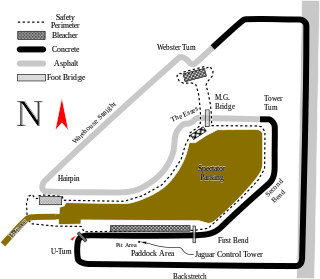
The 1956 Florida International Grand Prix of Endurance powered by Amoco took place on 24 March, on the Sebring International Raceway,. It was the second round of the F.I.A. World Sports Car Championship. For the sixth running of the event, was a sign to many in the automotive community that this race had become North America's premier sports car race, and from an international standpoint second only to the 24 Hours of Le Mans.

The 1956 Sveriges Grand Prix took place on 12 August, at the Råbelövsbanan, Kristianstad. Although this was the second running of the race, it was the first time as a round of the F.I.A. World Sports Car Championship. The previous year's race, won by Juan Manuel Fangio was the first big race held in Sweden, and the organiser, Kungl Automobil Klubben dealt with it so well, the F.I.A. promoted the race. For this year's event, the circuit was widened and resurfaced.
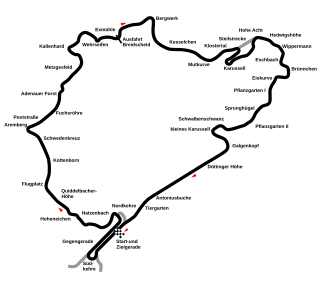
The 2. Internationales ADAC 1000 Kilometer Rennen auf dem Nürburgring took place on 27 May, on the Nürburgring Nordschleife,. It was also the fourth round of the F.I.A. World Sports Car Championship. This was the first time the event had taken place, since it was dropped from the championship following its inaugural event in 1953. It was also round two of the German Sportscar Championship.

